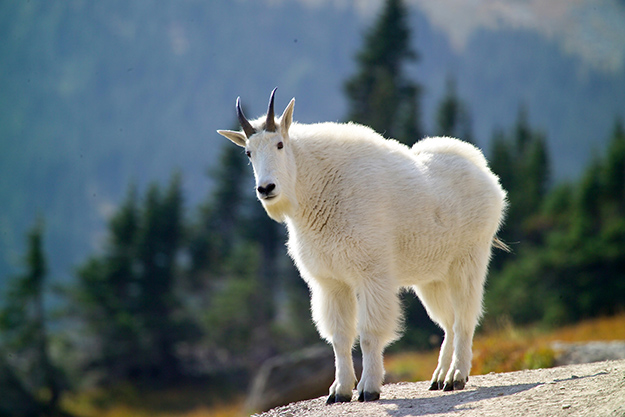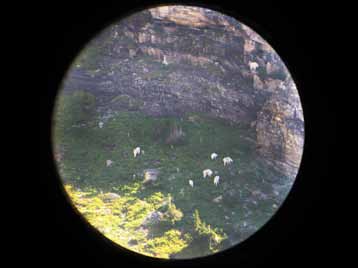Background Information

NPS
Threats
Mountain goats are commonly seen in Glacier National Park. It’s estimated that the park has one of the largest populations of mountain goats in the lower 48 states. However, declining numbers in parts of the Crown of the Continent Ecosystem and pressures from climate change are causing concern for the health of this species. Like other alpine species, mountain goats are sensitive to habitat conditions. They rely on high, cool, rocky terrain for their survival. Glacier is currently experiencing warming three times the global average at higher elevations. It is uncertain how a warming climate will affect mountain goats, but the park is near the southern extent of the mountain goat’s native range. If climatic conditions continue to shift, goat populations at the southern end of their range will cease to exist and the overall suitable habitat for mountain goats will shrink.
One of Glacier National Park’s iconic species, the mountain goat is only found in the northern latitudes of North America, and is more closely related to serows and chamois from Eurasia than to domestic goats. Some mountain goat populations now found in the U.S. were introduced, but Glacier’s goats are native to the landscape. Mountain goats primarily inhabit alpine and subalpine environments and are often found traversing nearly vertical cliffs. They are exceptional climbers, using their large, muscular forequarters to climb steep slopes of 60 degrees or more. Mountain goats have cloven hooves, or a hoof split into two toes, which spread out when needed. This stability, along with flexible, soft inner pads, allows the goats to grip the rocky ledges and cliffs they inhabit.
Summer months provide abundant food for mountain goats including a variety of alpine flowers, grasses, and sedges. During the long winter months, the mountain goat’s diet is more sparse. They winter high on steep cliffs where snow sheds readily or in areas where little snow accumulates. Here they find exposed vegetation not eaten during the summer as well as shrubs and lichens. Although treacherous, these steep cliffs not only provide food for the goats, but also offer protection from predators.
Status and Trends
The health and continuity of mountain goats is one indicator of a healthy alpine ecosystem. At the center of the Crown of the Continent Ecosystem, Glacier National Park provides critical protection and preservation for this species of concern. In 2008, state wildlife agencies reported large declines in goat populations in areas adjacent to the park. Concurrently, park biologists began to observe a decline in the number of goats found at the Walton Goat Lick.
Population trends for wildlife species like mountain goats can take many years to determine. Depending on food, weather, and predators, goat groups can move around widely within their home ranges. This makes it difficult to accurately predict population densities. A large group may frequent one aspect of a mountain daily, then not appear at all for a week. To understand changes in the overall mountain goat population, Glacier’s resource managers needed to gather baseline data on them—a difficult task, considering the significant amount of staff and resources needed to monitor a species living in such rugged terrain. The most efficient method for counting mountain goats is through aerial surveys. Typically conducted with helicopters, these are expensive, depend on weather and permits, and can be invasive to goats. The need for an alternative approach spurred the creation of the High Country Citizen Science project, which uses a volunteer workforce to conduct ground surveys of mountain goats. Volunteers are trained in mountain goat ecology, identification, and classification of age and sex. Using survey equipment and protocols, they complete one-hour surveys at one of 37 specified sites. With this information, biologists can estimate annual mountain goat populations at survey sites. In 2009, statistical models were created using this data to produce an estimate of goat density at survey sites.
Program managers are refining the survey design to take fluctuations in recorded goat numbers into account. Using data collected since 2009, they are applying new statistical models to improve estimates of relative goat abundance at survey sites and to track changes in distribution over time.
Management Strategy

NPS
Park managers and researchers are exploring the full potential of the Citizen Science Program and other types of annual monitoring. Research on mountain goat/human interactions and impacts from climate change is also underway. Scientists use minimally-invasive capture methods to fit goats with GPS collars. The goal of these studies is to develop data on the effects of roads, adjacent trails, and people on goat distribution.
Studies of human-habituated goats in popular areas of the park show that goats have changed their behavior around people. In addition to seeking salt from human sources, habituated goats may also be using humans as shields from predators. Areas with more humans have fewer carnivores, which is advantageous for goats. Habituated goats may stop visiting natural mineral licks, forgoing an annual migration. They pass this information down to their young, changing patterns of goat distribution.
With visitation to Glacier reaching nearly 3 million people in recent years, more humans will continue to overlap with goats in the park. Goat/human interactions are of growing concern to human safety, animal health, and ecological consequences. By obtaining baseline data, monitoring populations, and studying individual collared goats, park managers hope to ensure the long-term health of this rugged, high-country icon of Glacier.
Resources for More Information
Glacier National Park Staff
- Jami Belt, Biologist, Crown of the Continent Research Learning Center
- Mark Biel, Natural Resources Program Manager
Documents and web sites
- Jami Belt and Paul Krausman. 2012. Evaluating Population Estimates of Mountain Goats Based on Citizen Science. http://doi.org/10.1002/wsb.139
- Wesley Sarmento and Joel Berger. 2017. Human Visitation Limits the Utility of Protected Areas as Ecological Baselines. https://doi.org/10.1016/j.biocon.2017.06.032
- High Country Citizen Science Project – https://www.nps.gov/rlc/crown/high-country-citizen-science-project.htm
The Crown of the Continent Research Learning Center
Phone: 406-888-7894; Email: glac_citizen_science@nps.gov
Website: www.nps.gov/rlc/crown
Downloadable pdf
Last updated: October 14, 2024
